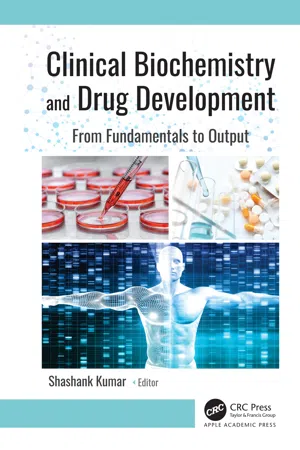
Clinical Biochemistry and Drug Development
From Fundamentals to Output
Shashank Kumar, Shashank Kumar
- 246 pagine
- English
- ePUB (disponibile sull'app)
- Disponibile su iOS e Android
Clinical Biochemistry and Drug Development
From Fundamentals to Output
Shashank Kumar, Shashank Kumar
Informazioni sul libro
This new volume focuses on clinical biochemistry fundamentals, cell culture techniques, and drug discovery and development concepts. It deals with three different fields of clinical research: cell culture, clinical biochemistry, and drug discovery and development.
The book introduces cell animal and bacterial culture techniques and their potential uses as well as cell culture techniques. The biochemistry aspect of the book covers the principles of clinical biochemistry and biochemical analysis, biochemical aids to clinical diagnosis, measurement, and quality control. The book also presents important concepts in cell membrane receptor signal transduction pathways as drug targets.
The drug development focus of the book discusses the fundamentals of human disease and drug discovery. Various in silico, in vitro, and in vivo approaches for drug discovery are examined, along with a discussion on drug delivery carriers and clinical trials. Overall, the volume provides an overview of the journey from clinical fundamentals to clinical output.
Domande frequenti
Informazioni
CHAPTER 1
An Introduction to Cell Culture
ABSTRACT
1.1 INTRODUCTION
| S. No. | Year | Scientist | Contribution | References |
|---|---|---|---|---|
| | ||||
| 1. | 1887 | Leo Loeb | Achieves cultured cells inside and outside of the body using “tissue culture in body” technique. | |
| 2. | 1907 | Ross Harrison | Cultured frog embryo nerve cells and monitored the development of fibers. | Harrison, 1910 |
| 3. | 1910 | Montrose Burrows | Cultured adult and embryonic tissue of dog | |
| 4. | 1912 | Alexis Carrel | Cultured connective tissue cells and showed contractility in heart muscle tissue | Carrel, 1912 |
| 5. | 1913 | Steinhardt, Israeli, and Lambert | Cultured vaccinia virus in the corneal tissue of guinea pig | |
| 6. | 1916 | Rous and Jone | Used trypsin to detach cells in culture disk | |
| 7. | 1946; 1947 | White, Fischer | Designed and developed a synthetic media for plant and animal cell culture | White, 1946 |
| 8. | 1948 | Katherine Sanford et al. | First time cloned the L-cells | Sanford et al., 1948 |
| 9. | 1949 | Enders, Weller, and Robbins | Grown Poliovirus in human embryonic cells in culture | |
| 10. | 1952 | George Gey | Established cancer cell line from HeLa cells | Gey, 1952 |
| 11. | 1954 | Abercrombie and Heaysman | Established contact inhibition between fibroblasts | Abercrombie and Heaysman, 1954 |
| 12. | 1955 | Harry Eagle | Defined media and described attachment factors and feeder layers | Hayflick and Moorhead, 1961 |
| 13. | 1956 | Little Field | Used hypoxanthin, aminopterin, thymidine medium for selection of cell selection | |
| 14. | 1961 | Hayflick and Moorhead | Established finite lifespan of normal human diploid cells | Eagle, 1959 |
| 15. | 1962 | Buonassisi | Developed method for the maintenance of tumor cell differentiation | Hayflick and Moorhead, 1961 |
| 16. | 1968 | David Yaffe | Worked on differentiation of normal myoblasts | Buonassisi et al., 1962 |
| 17. | 1969 | Augusti and Sato | Established neuroblastoma cells | |
| 18. | 1973 | Graham FL and van der Eb AJ | Introduced DNA in mammalian cell culture | Yaffe, 1968 |
| 19. | 1975 | Georges Kohler and Cesar Milstein | Developed first hybridomal cell secreting monoclonal antibody | |
| 20. | 1977 | Genetech | Developed the first human recombinant protein somatostatin | |
| 21. | 1985 | Collen | Produced Bacterial recombinant growth hormone accepted for therapeutic use | |
| 22. | 1997 | Wilmut, Schnieke, and colleagues | Produced transgenic sheep by using mammalian cell culture and nuclear transfer technique | Wilmut et al., 1997 |
| 23. | 2002 | Clonei | Claimed the production of EVE (cloned human baby) | |
| 24. | 2009 | Nathalie Cartier-Lacave | Combined blood stem cell therapy with the gene therapy. | |
| 25. | 2010 | Freshney | Developed media for animal cell culture | Freshney, 1987 |
| 26. | 2012 | Maria Blasco | Established the first gene therapy against an aging | |
| 27. | 2013 | Brysek and co-workers | Developed media for animal cell... | |